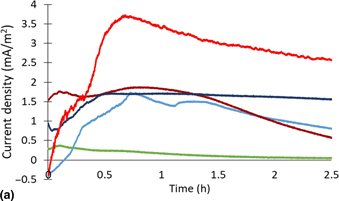Article contents
Peptide-mediated binding of gold nanoparticles to E. coli for enhanced microbial fuel cell power generation
Published online by Cambridge University Press: 20 June 2019
Abstract

The authors demonstrate that gold-binding peptides displayed on the outer membrane of Escherichia coli enhance bioelectrochemical charge transfer by binding gold nanoparticles. Microbial fuel cells were run with different gold-binding peptides displayed and with different nanoparticle sizes, and the results were correlated with transmission electron microscopy (TEM) imaging of nanoparticle binding. When a gold-binding peptide is displayed and 5 nm gold nanoparticles are present, up to 4× power generation over E. coli not displaying a gold-binding peptide is observed. While an enhanced current is observed using the previously published M6G9, the largest enhancement is observed when a new longer peptide named M9G18 is used.
- Type
- Research Letters
- Information
- Copyright
- Copyright © Materials Research Society 2019
References
- 6
- Cited by




